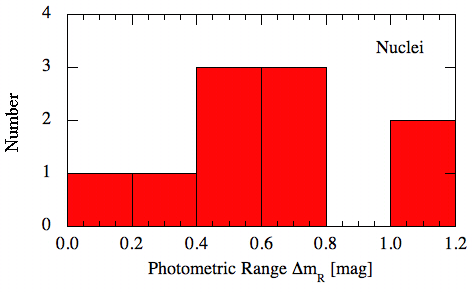 Cometary Nuclei |
 Impact Fragments |
|---|
|
Shape Evolution of Cometary Nuclei
David
Jewitt
Scott Sheppard
,
Yan Fernandez
Astronomical Journal, 2003, Astron. J., 125, 3366-3377.
|
|---|
In a Nutshell
The Kuiper belt is widely thought to be the source of the short-period
(specifically "Jupiter Family") comets. If so, one might expect the
physical properties of the latter to be like of impact fragments, as
produced in the laboratory by splintering impacts. To
test this expectation, we measured and compared the shapes of a
set of cometary nuclei with the shapes of impact produced fragments,
measured in the same way. The result, shown in the Figure below, is that
the two types of object have shape distributions which are NOT the
same. The most important difference is that the nuclei are, on the
average, more elongated than impact fragments. In case this difference
is an artifact of the difference in scale between the comets and the
laboratory impact samples, we also made a comparison with the shapes
of small main-belt asteroids. Again, the comet nuclei are much
more elongated than the asteroids.
 Cometary Nuclei |
 Impact Fragments |
|---|
How Could This Be?
The most likely explanation, and the one that we prefer, is that the observed
cometary nuclei are highly modified with respect to their Kuiper belt
counterparts. Shape is naturally modified by mass loss from the
cometary nucleus, whether the mass loss proceeds anisotropically or
not. Our data are consistent with the suggestion that the known
cometary nuclei are but shrivelled remnants of once larger nuclei. They
have lost much of their initial mass through sublimation induced by
heating by the sun. They could have started out with the modest axis
ratios shown by the impact fragments but their shapes have long since lost any
memory of this early phase.
So What?
If the comets have lost a big enough fraction of their mass as to
measurably change their shapes, then it is reasonable to expect that
the mass loss has been strong enough to also substantially modify
the rotations. In fact, rotation may have played a role in the
shape modification through centripetally induced break-up.
What we see in the nuclei of short-period comets are objects highly modified from their state when formed.
The paper itself as a PDF file.
Last updated April 2003